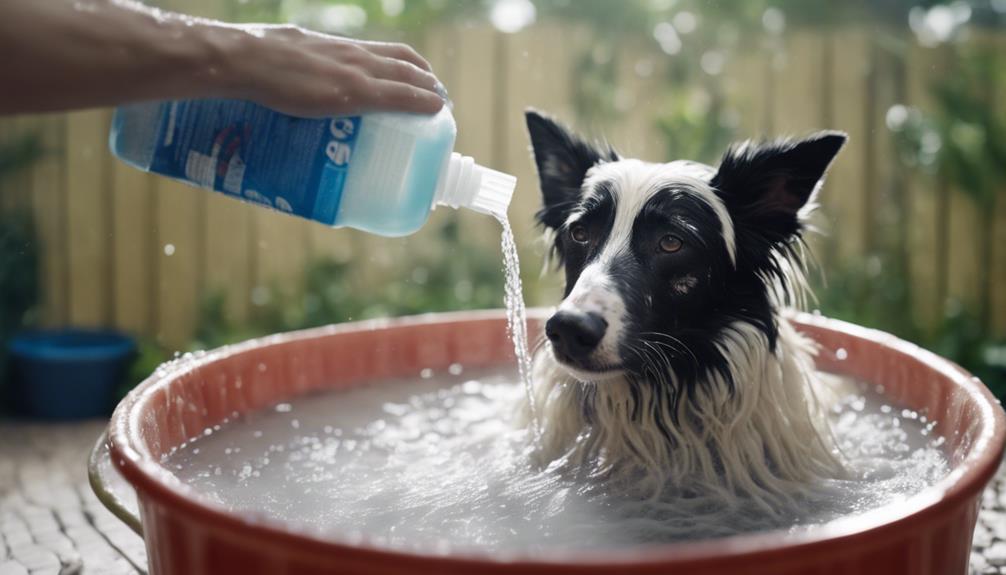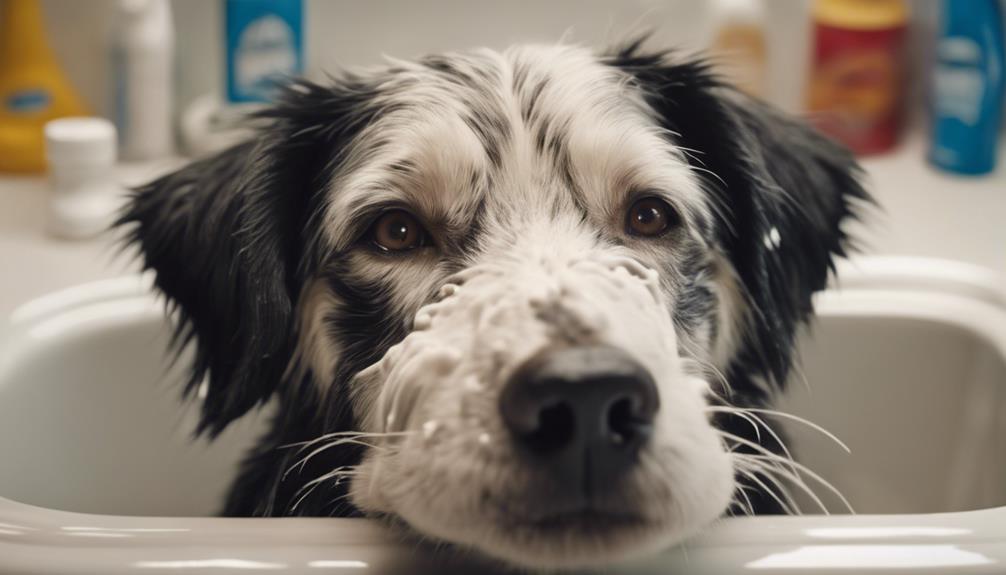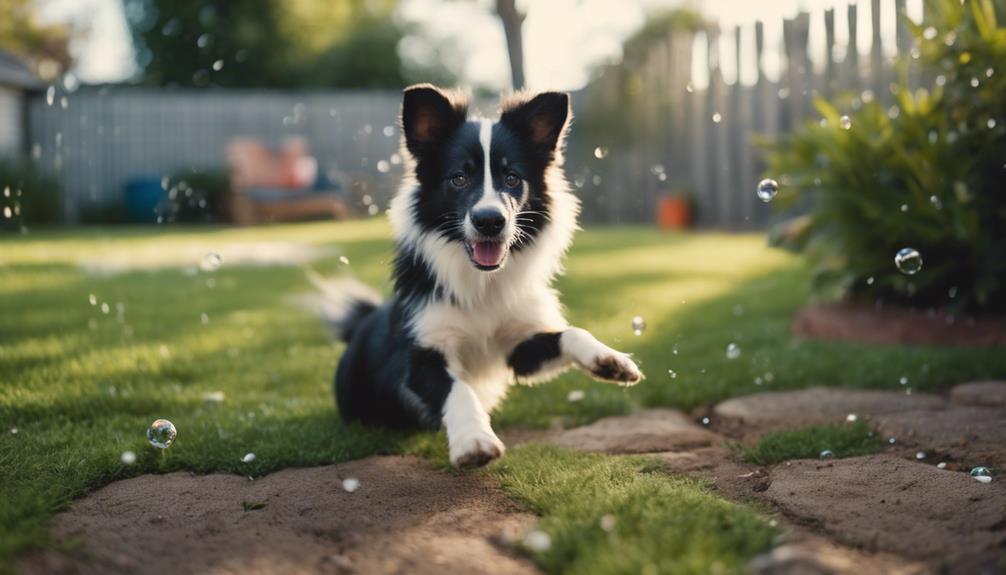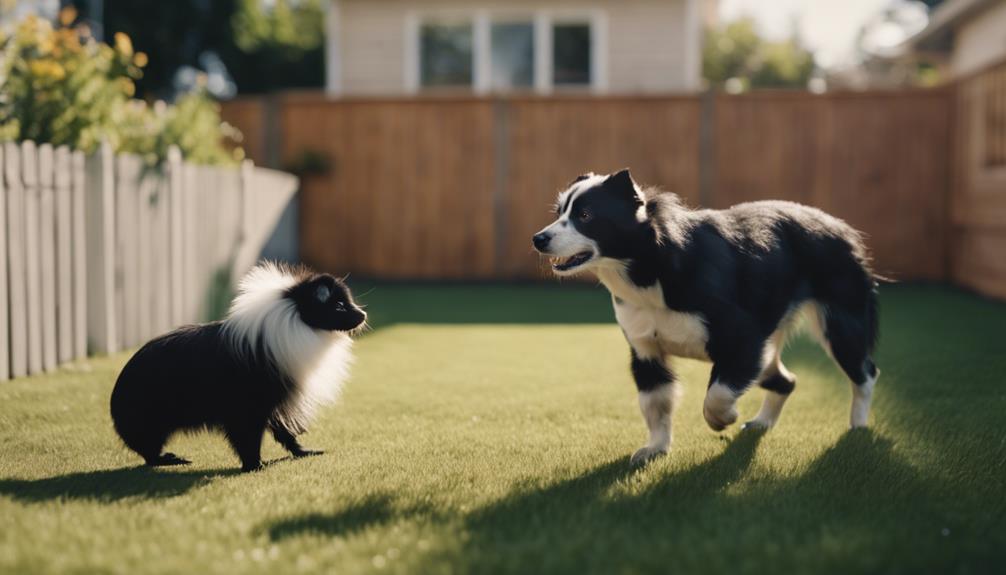Encountering a skunk and enduring the aftermath of its defensive spray can be a challenging ordeal for both your dog and you. The pungent odor left behind is not only unpleasant but can also be persistent if not handled correctly.
In this article, we will explore effective methods to eliminate the skunk smell from your dog and your surroundings. From DIY de-skunking solutions to preventative measures, we will equip you with the necessary knowledge to tackle this stinky situation head-on.
Stay tuned to discover the secrets to successfully restoring freshness after a skunk encounter.
Key Takeaways
- Skunk spray is a defense mechanism causing dogs to get sprayed as a deterrent.
- De-skunk your dog with a DIY deodorizer and proper washing techniques.
- Prevent future skunk encounters by securing trash bins and removing outside food bowls.
- Consult a vet if concerned about your dog's health after a skunk encounter.
Understanding Skunk Spray
When encountering skunk spray, it is essential to understand that skunks utilize this potent defense mechanism as a means of protection when they feel threatened.
Skunk spray is a noxious blend of chemicals primarily composed of sulfur-containing compounds, such as thiols, which give it its strong and enduring odor. This spray is released from the anal glands located near the skunk's tail and can reach distances of up to 10 feet accurately.
Skunks typically aim for the face of their perceived threat, as the eyes are particularly sensitive to the spray. Understanding the nature of skunk spray can help in developing effective strategies for both avoiding and addressing encounters with these creatures.
Post-Skunk Encounter Care
After understanding the nature of skunk spray and its effects, it is crucial to provide appropriate post-skunk encounter care for both your dog and the affected surroundings.
- Isolate Your Dog: Keep your dog outdoors to prevent the spread of the skunk smell indoors.
- Inspect for Injuries: Check your dog for any signs of injuries or irritation caused by the skunk spray.
- Ventilate Indoor Spaces: Open windows and use fans to help air out any affected areas within your home.
- Wash Dog's Belongings: Clean items such as collars, leashes, and bedding to remove any lingering skunk odor.
DIY De-Skunking Methods

To effectively remove skunk odor from your dog, employing do-it-yourself de-skunking methods is a practical and efficient approach. Here is a simple table outlining some effective DIY de-skunking methods:
| Method | Ingredients | Instructions |
|---|---|---|
| Hydrogen peroxide solution | Hydrogen peroxide, baking soda, dish soap | Mix ingredients, apply to dog, rinse |
| Vinegar solution | Vinegar, water, dog shampoo | Mix, wash dog, rinse thoroughly |
| Baking soda paste | Baking soda, water | Apply paste to affected areas, rinse |
These methods can help neutralize the skunk odor and restore your dog's freshness. Remember to thoroughly rinse your dog after applying these solutions for the best results.
Effective Odor Removal Techniques
Implementing proven methods for effective odor removal is crucial in successfully eliminating skunk smell from your dog. To achieve optimal results, consider the following techniques:
- Hydrogen Peroxide Mixture: Create a solution using hydrogen peroxide, baking soda, and dish soap for deodorizing.
- Proper Application: Apply the mixture generously to your dog's fur, ensuring thorough coverage.
- Fresh Preparation: Always prepare the deodorizer fresh for each application to maximize effectiveness.
- Protective Gear: Wear rubber gloves while deodorizing your dog to prevent direct contact with the skunk spray residue.
Proper Dog Washing Procedures

When it comes to proper dog washing procedures for removing skunk smell, thoroughness and careful technique are essential.
Begin by wetting your dog's fur thoroughly with lukewarm water. Apply a generous amount of dog shampoo or dish soap, ensuring to work it into a rich lather.
Focus on areas where the skunk spray is most concentrated, such as the face, neck, and chest. Be gentle to avoid irritating your dog's skin.
Rinse your dog's fur completely, making sure to remove all traces of the cleaning product.
Towel-dry your dog well, and if needed, allow them to air-dry in a warm, draft-free area. Remember to keep your dog warm throughout the process to prevent any discomfort.
Dealing With Dark Fur Challenges
In addressing challenges associated with dark fur during the de-skunking process, careful attention to thorough deodorizing techniques is crucial for effective odor removal. When dealing with dark fur, the following tips can help overcome specific challenges:
- Use a brightening shampoo specifically designed for dark fur to prevent discoloration.
- Consider using a color-safe dog shampoo to maintain the richness of the fur.
- Test any new deodorizing products on a small patch of fur to ensure compatibility.
- Seek advice from a professional groomer for specialized dark fur de-skunking recommendations.
Preventing Future Skunk Incidents

To deter future skunk incidents, proactive measures can be taken to minimize skunk attraction to your property. Implementing strategies like securing trash bins and removing outside food sources can help discourage skunks from frequenting your area. Additionally, cleaning up fallen fruit regularly and supervising your dog outdoors can reduce the likelihood of encounters. Below is a table summarizing key steps to prevent future skunk incidents:
| Preventive Measures | Description |
|---|---|
| Secure Trash Bins | Prevents skunks from scavenging for food. |
| Remove Outside Food Bowls | Reduces the appeal of your property to skunks. |
| Clean Up Fallen Fruit | Eliminates a potential food source for skunks. |
| Supervise Dog Outdoors | Helps prevent direct dog-skunk interactions. |
| Make Yard Less Appealing | Minimizes factors attracting skunks to your property. |
Maintaining Skunk-Free Outdoor Areas
Implementing effective strategies for maintaining a skunk-free outdoor environment is essential for ensuring the safety and comfort of both pets and residents. To achieve this, consider the following measures:
- Regularly inspect your property for any potential entry points where skunks could gain access.
- Keep outdoor areas well-lit during the night to deter skunks from lingering.
- Trim back bushes and shrubbery to reduce hiding spots for skunks.
- Securely store pet food and garbage in sealed containers to prevent attracting skunks to your yard.
Expert Tips for Skunk Prevention

Securing outdoor spaces against potential skunk invasions is paramount for maintaining a safe and harmonious environment for both pets and residents. Implementing effective skunk prevention measures can significantly reduce the risk of encountering these pungent creatures. Here are some expert tips to help you keep skunks at bay:
| Skunk Prevention Tips | Description | Benefits |
|---|---|---|
| Secure Trash Bins | Lock lids securely to prevent access. | Minimize food sources for skunks. |
| Install Motion Lights | Illuminate areas to deter skunks. | Skunks are nocturnal and avoid light. |
| Use Fencing | Erect barriers to keep skunks out. | Establish physical boundaries. |
| Plant Natural Deterrents | Grow plants skunks dislike. | Utilize natural repellents in landscaping. |
Conclusion
In conclusion, effective de-skunking methods are essential to mitigate the lingering stench on your dog after encountering a skunk.
By understanding skunk spray, utilizing DIY deodorizers, employing proper bathing techniques, and taking preventative measures, you can successfully eliminate the pungent odor and prevent future skunk incidents.
Remember to maintain skunk-free outdoor areas and follow expert tips for skunk prevention to ensure your canine companion remains odor-free.




